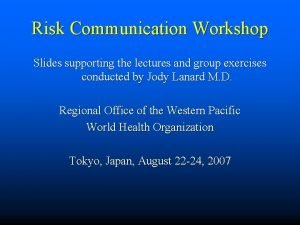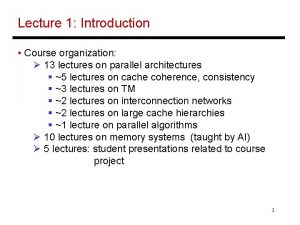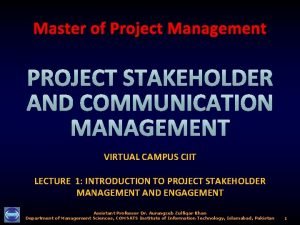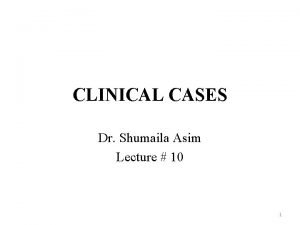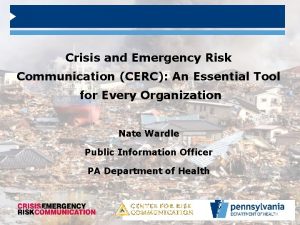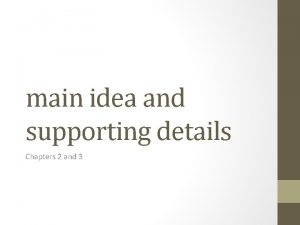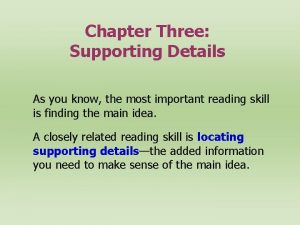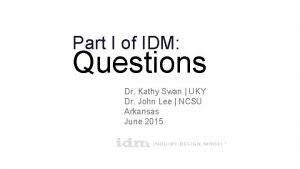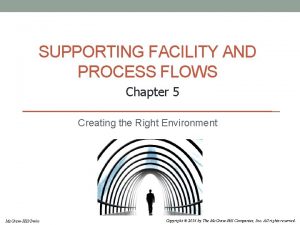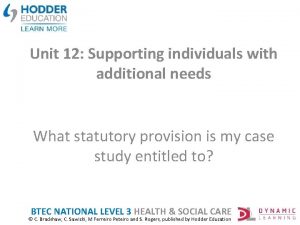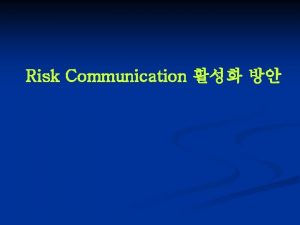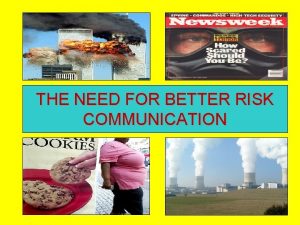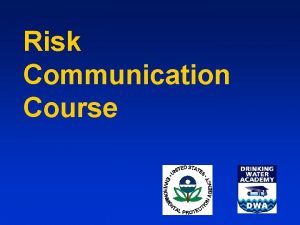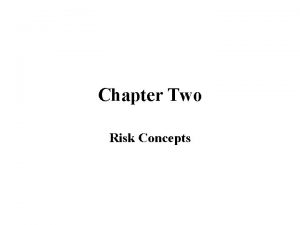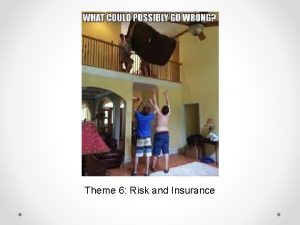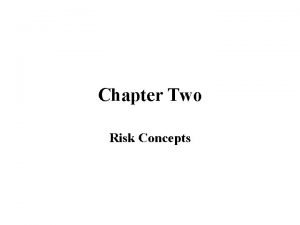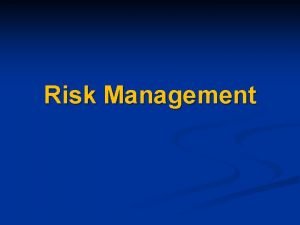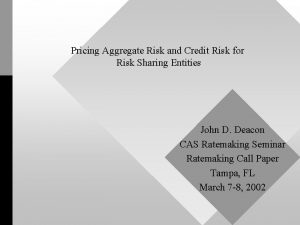Risk Communication Workshop Slides supporting the lectures and













































![“The EPA's [internal inspector]…criticized the agency's response, saying it did not have available data “The EPA's [internal inspector]…criticized the agency's response, saying it did not have available data](https://slidetodoc.com/presentation_image_h/dbcef6cc7e1e6a2b973419f65ed9fd9a/image-46.jpg)














































































![WHO's David Heymann shows his humanity, after issuing a global alert about SARS: “[It] WHO's David Heymann shows his humanity, after issuing a global alert about SARS: “[It]](https://slidetodoc.com/presentation_image_h/dbcef6cc7e1e6a2b973419f65ed9fd9a/image-125.jpg)












































![Who Outbreak Communication Guidelines n [Know and respond to] The public (strategies from this Who Outbreak Communication Guidelines n [Know and respond to] The public (strategies from this](https://slidetodoc.com/presentation_image_h/dbcef6cc7e1e6a2b973419f65ed9fd9a/image-170.jpg)











- Slides: 181

Risk Communication Workshop Slides supporting the lectures and group exercises conducted by Jody Lanard M. D. Regional Office of the Western Pacific World Health Organization Tokyo, Japan, August 22 -24, 2007

Overview, Days 1 and 2 Ice-breaker introductions exercise (see handouts and Workshop CDROM) Introduction to Risk Communication: How normal people perceive risk Four kinds of risk communication Quick exercise: Diagnose risk communication examples The WHO Outbreak Communication Guidelines: a brief introduction Crisis Communication 1: How bad is it? How sure are you? Quick exercise: Re-write typical risk announcements using strategies from Crisis Communication 1. Group exercise: Press statement confirming a meningitis outbreak (see handouts and workshop CDROM)

Overview, Days 1 and 2, continued Crisis Communication 2: Dealing with emotions in a crisis Quick exercise: Re-write typical risk announcements using strategies from Crisis Communication 1 and 2. Group exercise: Press statement updating the meningitis outbreak two weeks later (see handouts and workshop CDROM) Crisis Communication 3: Involving the public Crisis Communication 4: Correcting errors and misimpressions Full group: Quick oral quiz! Group exercise: Ten minutes in a car with your Minister, on the way to a press conference, confirming cholera outbreak in migrant worker camp near construction site of major international athletic venue. (see handouts and workshop CDROM)

Overview, Days 1 and 2, continued The WHO Outbreak Communication Guidelines: How they were developed, and then endorsed as best practices by 85 WHO and Member State outbreak responders from all parts of the world. (See handouts, workshop CDROM, or www. who. int/infectious-disease-news/IDdocs/whocds 200528 en. pdf ) Group exercise: Develop questions and answers / talking points for press conference about the cholera outbreak. Debriefing the first two days of the workshop

Who Outbreak Communication Guidelines n Trust n Announcing early n Transparency n The public n Planning

Risk Communication Paradigms n Watch out!! (precaution advocacy) n Calm down!! (outrage and fear management) n We’ll get through this together. (crisis communication)

One definition of risk communication: "The interactive process of exchanging information and opinion among individuals, groups, and institutions involving multiple messages about the nature of risk. . . “* -- The National Research Council (U. S. ) *(Note the emphasis on multi-directional communication!)

What “risk communication” is not: n “Educating the public” n One-way communication Talking to people who have no pre-existing views n Information you give out after you have made all your plans. n

Risk: a traditional definition The multiplication of Magnitude x Probability. How likely to happen? How bad if it happens?

Outrage Factors (How normal people estimate most hazards) “safe” “risky” Voluntary Controlled by self Trustworthy sources Responsive process Familiar Not memorable No moral relevance Not dreaded Chronic Involuntary Controlled by others Untrustworthy sources Unresponsive process Unfamiliar Memorable Moral relevance Dreaded Catastrophic © Peter Sandman 1987, 2006 (Based on the risk perception work of Paul Slovic)

A new definition of risk: Risk

A new definition of risk: Risk Hazard

A new definition of risk: Risk Hazard Outrage

A new “definition” of risk: Risk = Hazard + Outrage (Peter Sandman’s formula!)

For technical people: Risk = f( H, O )

Four Kinds of Risk Communication First communication planning task: Diagnose which “communication environments” are relevant. O U T R A G E Copyright 2003 Peter Sandman HAZARD

For this section of the workshop: Also see handout “Four kinds of risk communication” (In binder in English, Chinese, Japanese, and Korean)

Risk Communication Four kinds. Kinds of riskof communication 1. When people are ignoring a serious hazard O U T R A G E PUBLIC RELATIONS HEALTH & SAFETY EDUCATION ACTIVISM Copyright 2003 Peter Sandman HAZARD

Four Kinds of Risk Communication 1. When people are ignoring a serious hazard, contin. O U T R A G E Copyright 2003 Peter Sandman “Precaution Advocacy” HAZARD

1. When people are ignoring a serious hazard, contin. Four Kinds of Risk Communication Warning: next comes a concept that generates enormous resistance: O U T R A G E Copyright 2003 Peter Sandman “Precaution Advocacy” HAZARD

O U T R A G E Four Kinds of Risk Communication First, inform people – and mobilize their concern to a level of fear or worry proportionate to the hazard. (Officials hate the second half of this recommendation!!) Or F E A R Copyright 2003 Peter Sandman “Precaution Advocacy” HAZARD

O U T R A G E Then, help them manage the hazard (“things Four Kinds of Risk Communication they can do”), or else they will try to manage their fear (by way of denial, apathy, scoffing). Or F E A R “Precaution Advocacy” Copyright 2003 Peter Sandman HAZARD Fear Appeal Documentation

Four Kinds of Risk Communication In other words… O U T R A G E Or F E A R Copyright 2003 Peter Sandman “Precaution Advocacy” HAZARD Lower right hand circle, arrow

Four Kinds of Risk Communication O U T R A G E OUTRAGE MANAGEMENT Or “Precaution Advocacy” F E A R Copyright 2003 Peter Sandman HAZARD Upper Left Hand Circle

Four Kinds of Risk Communication O U T R A G E OUTRAGE MANAGEMENT Your Job: Inform people AND use outrage/fear management strategies to reduce their outrage or fear. Or F E A R Copyright 2003 Peter Sandman HAZARD

Four Kinds of Risk Communication In other words. . . O U T R A G E or OUTRAGE MANAGEMENT F E A R Copyright 2003 Peter Sandman HAZARD Upper Left Hand Circle, Arrow

Four Kinds of Risk Communication O U T R A G E OUTRAGE MANAGEMENT “Precaution Advocacy” Copyright 2003 Peter Sandman Two Arrows HAZARD

Three circles (adds crisis) O U T R A G E Copyright 2003 Peter Sandman CRISIS COMMUNICATION OUTRAGE MANAGEMENT “Precaution Advocacy” HAZARD

Four Kinds of Risk Communication O U T R A G E Copyright 2003 Peter Sandman Crisis Communication “We’ll get through this together” HAZARD Get through this together

(No way to make a living in this corner… Outrage or Fear © … but do communication surveillance to look for undiagnosed concerns, fear, or outrage) Hazard Peter Sandman 2004 www. psandman. com Low Hazard Low Outrage

Three main kinds of risk communication: Precaution advocacy, Outrage management, and crisis communication 1. Which kind of risk communication would you need to use most often? (List a few quick examples) 2. Which of the three is most important in public health? 3. Which of the three is hardest – and what makes it so hard in your country?

What kind of risk communication? n A public meeting to discuss evacuation and shelter plans for future typhoons.

What kind of risk communication? n A warning to evacuate immediately because rivers are starting to rise.

What kind of risk communication? n Information about routine childhood immunizations.

What kind of risk communication? n A public meeting after a child vaccinated against polio develops Vaccine Acquired Paralytic Polio.

What kind of risk communication? An press release requesting public comment about the location of hospitals designated for pandemic influenza patients.

What kind of risk communication? A press statement that the contaminated animal feed poses no threat to human health.

Who Outbreak Communication Guidelines Trust n Announcing early n Transparency n

Handout with list of 25 crisis communication recommendations n Crisis Communication: Guidelines for Action (contents) n 危机沟通: 行动指南 (目录) n 위기 상황 커뮤니케이션: 행동 지침 (내용) n クライシス・コミュニケーション:行動指針 (目次)



9/11 dust chasing people

9/11 overview dust

Bad example: Premature over-reassurance "We are very encouraged that…our monitoring of air quality and drinking water conditions…show that the public…is not being exposed to excessive levels of asbestos or other harmful substances… I am glad to reassure the people of New York…that their air is safe to breath and their water is safe to drink. " – U. S. Environmental Protection Agency Director Whitman, September 18, 2001 Christie Todd is pleased

In a lawsuit 4 years later… Judge Blasts Ex-EPA Chief “for reassuring Manhattan residents soon after the 2001 terrorist attacks that the environment was safe to return to homes and offices, while toxic dust was polluting the neighborhood. ” --NBC News, February 2006 Blasting Christie Todd Whitman
![The EPAs internal inspectorcriticized the agencys response saying it did not have available data “The EPA's [internal inspector]…criticized the agency's response, saying it did not have available data](https://slidetodoc.com/presentation_image_h/dbcef6cc7e1e6a2b973419f65ed9fd9a/image-46.jpg)
“The EPA's [internal inspector]…criticized the agency's response, saying it did not have available data and information to support the Sept. 18, 2001, statement that the air was safe to breathe. “The EPA's internal [inspector] found the agency, at the urging of White House officials, gave misleading assurances there was no health risk from the dust in the air after the towers' collapse. ” Blasting Christie, continued

How bad is it? How sure are you? 1. Don't over-reassure. When people are unsure or ambivalent about how worried they should be, they often become (paradoxically) more alarmed when officials seem too reassuring. This can lead to anger and skepticism as well, and to loss of essential credibility if the truth turns out more serious than predicted. A potential crisis is a classic high-magnitude lowprobability risk; if you keep assuring people how unlikely it is, they tend to focus all the more on how awful it would be.

Normal view of U. S. at night, from outer space

B l a c k o u t P h o t o

New York Blackout, 2003 9/11 jitters “Living close to the World Trade Center site and still having the 9/11 [worries], I thought the worst… “The first radio reports A blogger reassured everyone that it was not an act of terrorism. ” -- Leah Singer, blogger

Don’t over-reassure – bad example: New York Mayor Bloomberg, during the blackout “I can tell you 100 percent sure that there is no evidence as of this moment whatsoever of any terrorism. ” Talking to CNN, 7: 41 p. m. , August 14, 2003 Bloomberg example don’t over-reassure

Quiz: Bloomberg weasal words n What words “protect” him if he turns out wrong?

Answer: Bloomberg as of this moment “…as of this moment…”

What words did CNN run as a caption, while the Mayor spoke? CNN crawl? “? ? ? ? ”

For about ten minutes, CNN ran the words: 100% sure “ 100% sure”

See Saw

The See-Saw of Risk Communication

How bad is it? How sure are you? 2. Put reassuring information in subordinate clauses. 2. 将安慰人心的信息放在从句中。 2. 안심시키기 위한 정보는 하부 내용에서 설 명한다. 2. 安心感を与える情報は補足部分で述べる Subordinate Clause

. 2. Put reassuring information in subordinate clauses. When giving reassuring information to frightened or ambivalent people, it is helpful to de-emphasize the fact that it is reassuring. “Even though we haven’t seen a new case in 18 days, it is too soon to say we’re out of the woods yet. ”

Singapore “subordinates” the good news, and ends with a caution When WHO said that the SARS situation seemed to be improving in Singapore, the Minister of Health spokeswoman, Eunice Teo, was not so confident: “The WHO said the peak is over in Singapore, but our minister has said it is too early to tell. "

See Saw

Malaysia “subordinates” the good news, and ends with a caution: Veterinary Services Dr. Hawari Hussein said Malaysia was eligible to be declared "bird flu free, " after no new cases were detected for 21 days. But he added: health authorities were doing extra tests "to be absolutely sure. . . The threat is still there, from neighbouring countries. The tests are part of our own initiative to be sure. " (adapted from the Star on line, November 16 2004: Malaysia set to be declared free of bird flu)

U. S. CDC Director Julie Gerberding “subordinates” the good news, and ends with a caution: When asked if there was community transmission of SARS, Dr. Gerberding said: "Even though there is no sign of community spread, we are continuing intense surveillance and we're not out of the woods yet. "

U. S. CDC Director Julie Gerberding “subordinates” the good news, and ends with a caution: When asked if SARS could possibly be due to terrorism, Dr. Gerberding said: “Although this virus appears to be of entirely natural origin, we are being vigilant about all possibilities. "

One day, when there was very little important SARS news …

“Is SARS From Outer Space? ” –CNN headline, May 23, 2003 Photo from: http: //pardonbakarmisiniz. wordpress. com/files/2006/08/meteor-shower. jpg

U. S. CDC Director Julie Gerberding “subordinates” the good news, and ends with a caution: "Even though there is no evidence that SARS comes from outer space, we're keeping an open mind. ” -- Dr. Julie Gerberding, U. S. CDC copyright Peter Sandman and Jody Lanard 2006

Who Outbreak Communication Guidelines n Announcing early


. 3. Err on the alarming side. While it is obviously ideal to estimate risk correctly, if you have to get it wrong, it is wiser to err on the alarming side. In a fluid situation, the first communications should be the most alarming; “it’s better than we feared” is a far more tolerable day-two story than “it’s worse than we thought. ”

Early on in SARS, WHO’s Dick Thompson errs on the alarming side. “One might think we are overreacting to the cases. But when you do not know the cause, when it strikes hospital staff, ands it certainly is moving at the speed of a jet, we are taking this very seriously. ” – Dick Thompson --From the risk communication Good Example file. (Don't aim for zero fear; err on the alarming side; acknowledge people's "anchoring frames. “).

See Saw 3

Who Outbreak Communication Guidelines Trust n Announcing early n Transparency n

How bad is it? How sure are you? 4. Acknowledge uncertainty. 4. 承认不确定性。 4. 불확실성을 시인한다 4. 不確実性を認める Uncertainty

How bad is it? How sure are you? 4. Acknowledge uncertainty. Sounding more certain than you are rings false, sets you up to turn out wrong, and provokes adversarial debate with those who disagree. Say what you know, what you don’t know, and what you are doing to learn more. Show you can bear your uncertainty and still take action. Uncertainty

Warning people about uncertainty “We will learn things in the coming weeks that everyone will wish we had known when we started. ” This became the U. S. CDC’s theme after its early communication mistakes during the anthrax poisonings.

How bad is it? How sure are you? 5. Share dilemmas. 5. 与人分享两难困境。 5. 딜레마를 공유하기 5. ジレンマを伝える Share Dilemmas

. 5. Share Dilemmas When it is not obvious what to do, say so — even after you have decided what to do. Humanize your organization and its decision-making process by letting the pain of difficult decisions show. Explain the case for and against alternative options.

Australia Minister Tony Abbott shares pandemic planning dilemmas, in May 2005 “Of course, it’s impossible to say if, when and how a pandemic might develop. The next pandemic might be…mild like the flu outbreaks of the late 50 s and 60 s. “But it could also be a worldwide biological version of the Indian Ocean Tsunami. “There are obvious limits to how much governments can invest in preparations for hypothetical events, however serious. ”

WHO’s Dr. Rodier shares a dilemma “We are aware of the economic hardship that all travel advisories bring. We are aware, too, that some countries, looking at the example of Toronto, may choose to be less open and frank in their reporting of SARS — or any other epidemic-prone disease with the potential for international spread — for fear of the economic consequences. ”

How bad is it? How sure are you? 6. Acknowledge opinion diversity. 6. 承认有不同的意见。 6. 의견의 다양성을 시인한다 6. 意見の多様性を認める Opinion Diversity

. 6. Acknowledge opinion diversity Help the public learn that not all decisions are unanimous. Show that you can bear these differences within and between agencies, so they do not appear to be alarming fractures in your ability to cope with the crisis. Message consistency is still the ideal, but only if it reflects genuine unanimity. Message diversity is not harmful unless officials seem unaware of discrepancies or contemptuous of what other officials are saying

SARS in Singapore: To close the schools? Or not? In the middle of the SARS crisis, the Singapore government told the public about internal disagreements about whether to close the schools…

Osterholm warning about meningitis During the 2001 U. S. anthrax poisonings, Michael Osterholm talked about the importance of telling people what to expect. Here is an excerpt from the October 28, 2001, New York Times.

(Osterholm strategy, continued) The explanations have to include bad news along with the good, said Michael Osterholm. . Mr. Osterholm said he gained hard experience during a 1995 outbreak of meningitis in Mankato, Minn. , where he oversaw vaccinations for 30, 000 residents in just four days.

(Osterholm strategy, continued) At the outset he was careful to warn townspeople that one out of seven people who were infected would probably die. Less than a week into the outbreak, a patient died; the news, he said, was accepted without "fueling the fire, " because "people had anticipated it could happen. -- Oct 28, 2001, New York Times

How bad is it? How sure are you? 7. Be willing to speculate –responsibly. 7. 勇于做推测。 7. 적극적으로 추측한다. 7. 積極的に推測する Speculate

. 7. Be willing to speculate – responsibly Refusing to speculate is better than speculating over-confidently and over-optimistically. But in a crisis you can’t just say you’ll have a report out next month; the information vacuum demands to be filled now. So take the risk of being misquoted or turning out wrong, and speculate. . . but always tentatively, and with due focus on the worst case.

Who Outbreak Communication Guidelines The public n Planning n

Coping with the emotional side of the crisis 8. Don't overdiagnose or overplan for panic.

Panic in Baseco shanty town fire? "Residents were screaming and running in the streets in panic to save their lives and their families. The firefighters arrived at the scene, but could not immediately control the fire because of the chaotic situation. "

Panic in Baseco barangay fire? In the next sentence, the author notes the huge amount of physical damage to buildings housing 15, 100 people, observing that there were also 49 injuries but no fatalities. 49 injuries, no deaths – out of 15, 100 !!

Panic in Baseco barangay fire? Almost by definition, the self-rescue was effective. The residents knew their way around the alleys better than the incoming firefighters, and got everyone out with only a few injuries and no deaths. Undoubtedly it looked chaotic to the firefighters. What is typical is the assumption on the part of the officials that the behaviour was panic – despite the fact that it was part of an effective and successful self-organized rescue operation.

Coping with the emotional side of the crisis 8. 9. Don't overdiagnose or overplan for panic. Don't aim for zero fear. Zero Fear

What is the “right” level of fear? PANIC DENIAL TERROR FEAR CONCERN INTEREST APATHY

What is the “right” level of fear? PANIC DENIAL TERROR FEAR “HIGH CONCERN” ? ? ? CONCERN INTEREST APATHY

What is the “right” level of fear? PANIC Sometimes, a degree of rational fear is appropriate! DENIAL TERROR FEAR CONCERN INTEREST APATHY

Coping with the emotional side of the crisis 8. Don't overdiagnose or overplan for panic. 9. Don't aim for zero fear. 10. Don't forget other emotions (besides fear). Don’t forget other emotions

Emotional Responses to Crisis 1. 2. 3. 4. 5. 6. Fear Empathy/Misery Anger Hurt Guilt Resilience! List other emotions

Coping with the emotional side of the crisis 11. Don't ridicule the public's emotions. Don’t ridicule emotions

Coping with the emotional side of the crisis 11. 12. Don't ridicule the public's emotions. Legitimize people's fears. Legitimize Fears

SARS: Singapore’s Prime Minister validates fear – and courage “Our health-care workers put their lives at risk every day they went to work… 'They were frightened. But they conquered their fear with courage. Courage in tending to an infected patient. Courage in taking respiratory fluid samples from the throat. Courage in cleaning the wards every night. “We saw this courage in our doctors, nurses and other health-care professionals; in the attendants, security officers and cleaners in our hospitals. ” --Prime Minister Goh, at SARS Memorial Ceremony, July 23, 2003. Straits Times

Goh involves the public and legitimizes fear: Closing the schools during SARS Open respectful expert disagreement

PM Goh and SARS fear While acknowledging SARS fear - his own, as well as his citizens' - PM Goh nearly always pivoted from the subject of fear to action and courage. Excerpt from PM Goh’s National Day speech in August 2003: S-A-R-S = "Schools Are Really Shut!" … "Single And Really Sexy!" “Singaporeans Are Really Scared”. Yes, we were really scared. Scared for our lives and our loved ones. Scared of taking a taxi, scared of going to the hospital. Scared that tourists and customers would not return, and we might lose our jobs. For the first time in our history, all Singaporeans felt the same fear at the same time. But far from being frozen by the fear, the entire nation sprang into action. "

Coping with the emotional side of the crisis 13. Tolerate early over-reactions. 13. 容忍事件早期公众的过度反应。 13. 초기 과잉반응을 용인한다. 13. 最初の過剰反応を受け入れる Tolerate Early Reactions

. 13. Tolerate early over-reactions. One of the main ways people absorb new risks is by taking precautions that are unnecessary or premature. This is a form of rehearsal, both logistical and emotional; it also helps personalize the risk. Unless these over-reactions cause significant harm, they should be tolerated; they will settle soon enough into the “new normal. ”

Adjustment Reactions --- the Teachable Moment in crisis communications! You can respect and guide it. Or you can waste the opportunity by ridiculing people’s fears and their efforts to protect themselves.

or Fear Initial Reaction Start of crisis Time Tolerate Early Over-reactions: Use the “Teachable Moment” Curve Adjustment Reaction

A typical example from AI poultry outbreaks: First, people stop eating poultry. Then, officials tell the public: “Properly cooked poultry is perfectly safe. ” Then, officials say that people are irrational, hysterical, and panicking. Then officials have a big chicken-eating party, with reporters and cameras filming the event.

What to do when bird flu arrives, to empathize with people’s fears? Have a chicken eating festival to prove it is safe? Other ideas? 1. 2. 3. 4.

Acknowledge that culling is disgusting Culling:

Acknowledge that culling is disgusting Culling:

Acknowledge that culling is disgusting Culling:

Acknowledge that culling is disgusting Culling:

Culling IS disgusting! n .

Are we hungry yet? State agriculture officials and celebrities staged photo opportunities for the media From http: //birdflubook. com/a. php? id=79

Former PM Thaksin ignores the “adjustment reaction” -… by cheerfully eating chicken

If Mr. Thaksin understood the adjustment reaction, what might he have said? : 1. 2. 3. 4.

Bad example – ridiculing the public, when bird flu came to Italy: “There is no reason to change eating and behavioural habits. . There’s no need for chicken psychosis… This psychosis is not justified. ” --Former Italian Health Minister Storace, when Italy had its first bird flu outbreak WHAT SHOULD HE HAVE SAID INSTEAD?

What the Republic of Lao Health Minister did instead of a chicken-eating party: Clean Cook thoroughly Chill Avoid Cross-contamination

Lao showed concern for people’s health While most governments demonstrated concern for trade and industry, the Republic of Lao showed its Ministers in the kitchen of a restaurant, learning how workers protect themselves while preparing poultry. They showed concern for people’s health. This builds trust with the public.

Another rare and wonder example: Nigeria validates the adjustment reaction, and tells people what to expect: "However, we have observed that in other countries experiencing their first human H 5 N 1 cases, there has been widespread fear of poultry and poultry products, with a …drop in consumption and sales. “For a short time, that may happen in Nigeria too. It is entirely understandable that the population may be overtly worried about all chickens, not just sick chickens. ” Nigeria Avian Influenza Crisis Management Center, Bulletin 29, early 2007

Who Outbreak Communication Guidelines n Trust

Coping with the emotional side of the crisis 14. Establish your own humanity. 14. 表现出你自己人性的一面。 14. 자신의 인간적 측면을 보여준다. 14. 自分自身の人間性を確立する Establish Humanity
![WHOs David Heymann shows his humanity after issuing a global alert about SARS It WHO's David Heymann shows his humanity, after issuing a global alert about SARS: “[It]](https://slidetodoc.com/presentation_image_h/dbcef6cc7e1e6a2b973419f65ed9fd9a/image-125.jpg)
WHO's David Heymann shows his humanity, after issuing a global alert about SARS: “[It] was a pretty radical decision, and I didn't sleep that night because I knew that we were doing was going to have a lot of different repercussions. ”


. 15. Tell people what to expect. “Anticipatory guidance” — telling people what to expect — is especially useful (and difficult) in two situations: When it’s about uncertainty and possible error (“we will learn things in the coming weeks that everyone will wish we had known when we started”); and when it’s about bad outcomes (“the statistical mortality figure will probably go up as some of these very sick patients die”).

Thailand tells people what to expect, and does not over-reassure: “We are now about 80% ready to deal with a bird flu outbreak should it happen today. ” --Thai Deputy Prime Minister Chaturon Chaisaeng, 9 February, 2005, Bangkok Post

Thailand tells people what to expect, does not over -reassure, and acknowledges uncertainty: “The first wave of bird flu outbreak has passed. . . but we don’t know when the second wave will come, and we don’t trust the situation. . So the Public Health Ministry is being as careful as possible. ”

Bulgaria “tells people what to expect: ” Agriculture Minister Nihat Kabil said that… he expected the latest Bulgarian samples to test positive for this strain. "We suppose, after all [the other] samples sent from southeast Europe tested positive for H 5 N 1, the [Bulgarian] samples that will be sent tomorrow will, with very high probability, also test positive for H 5 N 1. " Bulgaria tell people what to expect

Bulgaria, continued: Kabil said he feared it was only a matter of time before H 5 N 1 appeared in domestic poultry. "It is not necessary to start culling domestic birds. . . (but) we have to accept the thought that in the coming days we might have the first outbreak. “The probability of that is very high and we have to be ready for pictures of veterinarians going into those areas with special suits to cull birds. “ (Reuters)

Tell people what to expect "This is going to be a long slog, and a lot of people are going to suffer economically before we get to the end of this. “ -- Peter Cordingley, WHO spokesman, as H 5 N 1 bird flu continued to spread throughout Asia in 2004. --Channel. News. Asia, August 20, 2004.

When Hong Kong found a wild bird with H 5 N 1 avian flu, December 2006 — WHO spokesperson Peter Cordingley speculated responsibly: “While we don't have a lot of information on this, I think it would be logical to suggest that it was infected in southern China… We have to ask ourselves whether the virus is circulating unnoticed there? '' (statement to Bloomberg News, Jan 11, 2007)

After the first big Asian meeting about avian influenza, WHO spokesman Peter Cordingley came out and briefed the press. One of his statements: . title . “Officials appeared shaken. ” On August 8, 1997, Kanta Subbarao, from the U. S. CDC’s influenza branch, learned that the virus which caused the mysterious death of a Hong Kong child about three months earlier was H 5 N 1 – a novel flu virus in a human being. Dr. Subbarao told a reporter about working with a nearby Agriculture lab to get avian flu reagents to test freeze-dried samples from the dead child: –“[There was a certain amount of panic…It was pretty exciting, but it was scary. There was a certain amount of dread. "

Involving the public 16. Offer people things to do

Involving the public 16. Offer people things to do. Self-protective action helps mitigate fear; victim-aid action helps mitigate misery. All action helps us bear our emotions, and thus helps prevent them from escalating into panic, flipping into denial, or declining into hopeless apathy. Plan for this well in advance; mid-crisis is a harder time to start figuring out what to offer people to do -- including the legions of volunteers who will want to help. Offer people things to do

Involving the public 17. Let people choose their own actions. Let People Choose

Involving the public 17. Let people choose their own actions. Offering people a choice of actions recruits not just their ability to act, but also their ability to decide. This makes it all the more empowering as a bulwark against panic or denial. Ideally, bracket your action recommendations with less and more extreme options, so people who are less concerned or more concerned than you wish they were do not need to define themselves as rebels; you have recommendations for them too. Let People Choose

Singapore’s Dr. Balaji acknowledges uncertainty, and lets people choose their own actions: SARS masks, during SARS outbreak. During a television call-in show, Minister of State for Health Balaji Sadasivan was asked by a caller about whether to wear masks in public, and what kind to use. At this point, it seemed very likely, but not yet 100% definite, that SARS was mostly transmitted by close personal contact, through droplets and touching contaminated surfaces.

Dr. Balaji acknowledges uncertainty, and lets people choose their own actions: SARS masks Dr. Balaji told the caller that there was no evidence that wearing a mask [in public] helps, and no evidence that it doesn't help, and that is why they hadn't given a definite recommendation at that point. But the MOH explained how to wear masks properly, if people decided they wanted to wear them.

The SARS mask example showed: Acknowledging uncertainty. Legitimizing people’s fears. Letting people choose their own actions (and helping them do it right).

Involving the public 18. Ask more of people

18. Ask more of people. In a crisis, pro-social, resilient impulses “fight” with less desirable impulses: panic, passivity, selfishness. Join with the former against the latter by asking more of people. • Ask for people’s help before the crisis as well as during it. • Ask them to help their community and their neighbors (and your organization), not just themselves -- but do ask them to help themselves. • Ask more of people emotionally too. Give us “permission” to find the situation unbearable, but make it clear that you expect we will be able to bear it. Ask more of people

Adult resilient response? Emergency Ambivalence or Regressed dependent response? Ask More of People: Ally with Our Adult Selves! Ally with adult side

Singapore shares emotions about SARS commemoration ceremony, Singapore, Summer 2003

“Heroes and Angels / Through Your Eyes” – the SARS anthem, Singapore

“Heroes and Angels / Through Your Eyes” – the SARS anthem, Singapore

“Heroes and Angels / Through Your Eyes” – the SARS anthem, Singapore Overwhelmed by emotion, a nurse sheds a tear as she watches a patient suffering from SARS. http: //www. wpro. who. int/sites/whd/heroes/singapore/pic 10. htm

“Heroes and Angels / Through Your Eyes” – the SARS anthem, Singapore

Acknowledge Errors, Misimpressions, and Half-truths 19. Acknowledge errors, deficiencies, and misbehaviors.

Canada protests WHO travel advisory, WHO’s Dick Thompson acknowledges some blame Canadian official: “We believe this decision was made without consulting the province – we believe it was an over-reaction. ” “The medical evidence does not support this advisory. ” WHO’s Dick Thompson: “There was a breakdown in communications. I think that we’re willing to acknowledge that there was some kind of mistake, that they didn’t receive the message. And I think we’re ready to accept some blame here. ”

Singapore acknowledges error In mid-May, 2003, there was an unexpected potential new outbreak of SARS at a Singapore mental hospital. Before this turned out to be a false alarm, the Singapore Straits Times wrote: "SARS Combat Unit Chief Khaw Boon Wan. . admitted that the fresh batch of possible cases at the Institute of Mental Health had caught him unprepared. The chronic-care hospital 'was not on my radar screen, " [he] confessed, 'because we just didn't have the time to focus on it. It was a tactical error. "

Acknowledge Errors, Misimpressions, and Half-truths 19. 20. Acknowledge errors, deficiencies, and misbehaviors. Apologize often for errors, deficiencies, and misbehaviors. Apologize for Errors

Acknowledge Errors, Misimpressions, and Half-truths 21. Be explicit about "anchoring frames*. ” *what people already know and believe; their “mental models. ” Anchoring Frames

Suppose… You want parents to use child car seats. You found out Hispanic parents are particularly resistant. Why? From Dr. Wm. Smith, Academy for Educational Development, slides on line at: http: //www. izcoalitionsta. org/content. cfm? id=514

My child is always safest in my arms. God decides when to take my baby. From Dr. Wm. Smith, Academy for Educational Development, slides on line at: http: //www. izcoalitionsta. org/content. cfm? id=514

Have a priest bless the car seats. From Dr. Wm. Smith, Academy for Educational Development, slides on line at: http: //www. izcoalitionsta. org/content. cfm? id=514

Acknowledge Errors, Misimpressions, and Half-truths 21. 22. Be explicit about "anchoring frames. " Be explicit about changes in official opinion, prediction, or policy. Changes in Policy

FAO official acknowledges error re: best guess about AI spread, after over -emphasizing possible role of migratory birds: "Many of us at the outset underestimated the role of trade. ” -- FAO’s Sam Jutzi, director of Animal Production and Health, February 12 2007

Acknowledge Errors, Misimpressions, and Half-truths 23. Don't lie, and don't tell halftruths. Don’t Lie…

-The Nation Newspaper, Bangkok -16 January 2004 -from a WHO/Thai risk comm presentation WHO/Thai slide 1

-Bangkok Post, 17 January 2004 From a WHO/Thai risk comm presentation Thai farmers claim cover up

“As public servants, they (the authorities) should be ashamed of themselves for failing to perform their duties in a straight forward manner. ” -The Nation Newspaper, 25 January 2004 -From a WHO/Thai risk comm presentation. Thai Chicken Lies

Acknowledge Errors, Misimpressions, and Half-truths 23. 24. Don't lie, and don't tell halftruths. Aim for total candor and transparency. Aim for total…

Acknowledge Errors, Misimpressions, and Half-truths 25. Be careful with risk comparisons. Risk Comparisons

Who Outbreak Communication Guidelines n Trust n Announcing early n Transparency n The public n Planning

Who Outbreak Communication Guidelines n Trust (strategies from this workshop) – Don't over-reassure. – Share dilemmas. – Acknowledge opinion diversity. – Tolerate early "over-reactions. " – Acknowledge and apologize for errors and deficiencies. – Be explicit about changes in policy and predictions.

Who Outbreak Communication Guidelines n Announcing early (strategies from this workshop) – Don't over-reassure. – "Err on the alarming side. " (Most extreme: discuss your own worst cases; respond to worst cases others are concerned about. ) – Acknowledge uncertainty. – Tolerate early "over-reactions. " – Be willing to speculate (responsibly). – Tell people what to expect.

Who Outbreak Communication Guidelines n Transparency (strategies from this workshop) – Don't over-reassure. – "Err on the alarming side. " (Most extreme: discuss your own worst cases; respond to worst cases others are concerned about. ) – Acknowledge uncertainty. – Share dilemmas. – Acknowledge opinion diversity. – Establish your own humanity. – Tell people what to expect. – Acknowledge and apologize for errors and deficiencies. – Be explicit about changes in policy or predictions.
![Who Outbreak Communication Guidelines n Know and respond to The public strategies from this Who Outbreak Communication Guidelines n [Know and respond to] The public (strategies from this](https://slidetodoc.com/presentation_image_h/dbcef6cc7e1e6a2b973419f65ed9fd9a/image-170.jpg)
Who Outbreak Communication Guidelines n [Know and respond to] The public (strategies from this workshop) – Be willing to speculate (responsibly). – Don't ridicule the public's emotions ("irrational, hysterical"). – Legitimize people's fear and other emotions. – Tolerate early "over-reactions. " – Offer people things to do. – Let people choose their own actions [from a range]. – Ask more of people. – Acknowledge and empathize with people's starting beliefs and attitudes, before trying to change them.

Who Outbreak Communication Guidelines n Planning (strategies from this workshop) – Acknowledge and empathize with people's [policy and subject expert's] starting beliefs and attitudes before trying to change them. – Validate how counter-intuitive a lot of these strategies are. – Include risk communication planners in every stage of risk assessment and risk management.

WHO Outbreak Communication Wallet Card!

. See also: WHO’s Outbreak Communication Best Practices for communicating with the public during an outbreak: The report of the WHO Expert Consultation on Outbreak Communications held in Singapore, 21 -23 September 2004 http: //www. who. int/csr/resources/publications/ WHO_CDS_2005_32 web. pdf and on the workshop CDROM.

. Some notes for preparing questions and answers / talking points Communication Goals Desired headlines Feared headlines Anticipated questions Feared questions Different audiences: Domestic, National, International, other Ministries? What you want them to know: What they want to know: Barriers to public understanding Barriers to public acceptance of message Media needs Ensure message is what you mean to say

More talking point guidance n Think of three or four “hot words” – words that “capture” the situation. n Such as: “Situation unclear” “Seeking clarification” “Regret shortcomings” End: Close with the message that supports the ideal headline. n n (See also: 77 Questions most often asked by reporters, by Vincent Covello, in handouts. )

Feel free to adapt any of these slides for your own purposes! (with appropriate credit if it is due. )

. For example ….



That ends Jody Lanard’s section of this workshop. Tomorrow: An expert with front line experience on both sides of the reporter/source divide: WHO’s Peter Cordingley on Media and Spokesperson Skills . Peter Cordingley, right, reporting for Agence France-Presse (AFP) in Saigon, 1975 PC acknowledging uncertainty about a sudden increase in human cases of AI in Viet Nam, June 2007

Crisis Communication: Guidelines for action, a 64 -page manual of handouts covering the material in this presentation is available for free, on line, on The Peter Sandman Risk Communication Website, www. psandman. com, at: http: //psandman. com/handouts/AIHA-DVD. htm Thank you!
 Risk workshop slides
Risk workshop slides Oral communication 3 lectures text
Oral communication 3 lectures text Credit risk market risk operational risk
Credit risk market risk operational risk A small child slides down the four frictionless slides
A small child slides down the four frictionless slides Change in energy quick check
Change in energy quick check Utilities and energy lectures
Utilities and energy lectures Theory of translation lectures
Theory of translation lectures Molecular biology lecture
Molecular biology lecture Rick trebino
Rick trebino Neonatology lectures
Neonatology lectures Data mining lectures
Data mining lectures Medicinal chemistry lectures
Medicinal chemistry lectures Uva powerpoint template
Uva powerpoint template Cs614 short lectures
Cs614 short lectures Activity planning in software project management
Activity planning in software project management Radio astronomy lectures
Radio astronomy lectures Dr sohail lectures
Dr sohail lectures Web engineering lectures ppt
Web engineering lectures ppt Do words have power
Do words have power Frcr physics lectures
Frcr physics lectures Rotating anode
Rotating anode Introduction to recursion
Introduction to recursion Blood physiology guyton
Blood physiology guyton What is aerodynamics
What is aerodynamics Theory of translation lectures
Theory of translation lectures Power system lectures
Power system lectures Translation 1
Translation 1 Digital logic design lectures
Digital logic design lectures Computer networks kurose
Computer networks kurose Hegel philosophy
Hegel philosophy Nuclear medicine lectures
Nuclear medicine lectures Cs106b
Cs106b Cdeep lectures
Cdeep lectures C programming lectures
C programming lectures Haematology lectures
Haematology lectures Bureau of lectures
Bureau of lectures Slagle lecture
Slagle lecture Theory of translation lectures
Theory of translation lectures Reinforcement learning lectures
Reinforcement learning lectures 13 lectures
13 lectures Reinforcement learning lectures
Reinforcement learning lectures Bba lectures
Bba lectures Medical emergency student lectures
Medical emergency student lectures Hematology
Hematology Rcog cpd portfolio
Rcog cpd portfolio Bhadeshia lectures
Bhadeshia lectures Yelena bogdan
Yelena bogdan Comsats virtual campus lectures
Comsats virtual campus lectures Hugh blair lectures on rhetoric
Hugh blair lectures on rhetoric Cern summer student lectures
Cern summer student lectures Pathology lectures for medical students
Pathology lectures for medical students Dr asim lectures
Dr asim lectures Ota resident lectures
Ota resident lectures Anatomy lectures powerpoint
Anatomy lectures powerpoint Cern summer school lectures
Cern summer school lectures Residual risk and secondary risk pmp
Residual risk and secondary risk pmp Business vs financial risk
Business vs financial risk Relative risk and attributable risk
Relative risk and attributable risk Attributable risk formula
Attributable risk formula Business communication lecture slides
Business communication lecture slides Risk projection attempts to rate each risk in two ways
Risk projection attempts to rate each risk in two ways Risk mitigation avoidance
Risk mitigation avoidance Relative risk calculation
Relative risk calculation Inherent risk vs control risk
Inherent risk vs control risk Absolute risk vs relative risk
Absolute risk vs relative risk Activity sheet 1 conservative moderate or speculative
Activity sheet 1 conservative moderate or speculative Medium term risk
Medium term risk Risk financing transfer dan risk retention
Risk financing transfer dan risk retention The biggest risk is not taking any risks
The biggest risk is not taking any risks Key risk indicators financial risk management
Key risk indicators financial risk management Ir x cr x dr
Ir x cr x dr Risk map risk management
Risk map risk management Crisis and emergency risk communication
Crisis and emergency risk communication Hát kết hợp bộ gõ cơ thể
Hát kết hợp bộ gõ cơ thể Ng-html
Ng-html Bổ thể
Bổ thể Tỉ lệ cơ thể trẻ em
Tỉ lệ cơ thể trẻ em Chó sói
Chó sói Glasgow thang điểm
Glasgow thang điểm Alleluia hat len nguoi oi
Alleluia hat len nguoi oi Các môn thể thao bắt đầu bằng tiếng đua
Các môn thể thao bắt đầu bằng tiếng đua Thế nào là hệ số cao nhất
Thế nào là hệ số cao nhất Các châu lục và đại dương trên thế giới
Các châu lục và đại dương trên thế giới Công thức tính độ biến thiên đông lượng
Công thức tính độ biến thiên đông lượng Trời xanh đây là của chúng ta thể thơ
Trời xanh đây là của chúng ta thể thơ Cách giải mật thư tọa độ
Cách giải mật thư tọa độ Phép trừ bù
Phép trừ bù độ dài liên kết
độ dài liên kết Các châu lục và đại dương trên thế giới
Các châu lục và đại dương trên thế giới Thể thơ truyền thống
Thể thơ truyền thống Quá trình desamine hóa có thể tạo ra
Quá trình desamine hóa có thể tạo ra Một số thể thơ truyền thống
Một số thể thơ truyền thống Bàn tay mà dây bẩn
Bàn tay mà dây bẩn Vẽ hình chiếu vuông góc của vật thể sau
Vẽ hình chiếu vuông góc của vật thể sau Biện pháp chống mỏi cơ
Biện pháp chống mỏi cơ đặc điểm cơ thể của người tối cổ
đặc điểm cơ thể của người tối cổ V cc cc
V cc cc Vẽ hình chiếu đứng bằng cạnh của vật thể
Vẽ hình chiếu đứng bằng cạnh của vật thể Vẽ hình chiếu vuông góc của vật thể sau
Vẽ hình chiếu vuông góc của vật thể sau Thẻ vin
Thẻ vin đại từ thay thế
đại từ thay thế điện thế nghỉ
điện thế nghỉ Tư thế ngồi viết
Tư thế ngồi viết Diễn thế sinh thái là
Diễn thế sinh thái là Dạng đột biến một nhiễm là
Dạng đột biến một nhiễm là Số nguyên tố là số gì
Số nguyên tố là số gì Tư thế ngồi viết
Tư thế ngồi viết Lời thề hippocrates
Lời thề hippocrates Thiếu nhi thế giới liên hoan
Thiếu nhi thế giới liên hoan ưu thế lai là gì
ưu thế lai là gì Sự nuôi và dạy con của hươu
Sự nuôi và dạy con của hươu Khi nào hổ mẹ dạy hổ con săn mồi
Khi nào hổ mẹ dạy hổ con săn mồi Hệ hô hấp
Hệ hô hấp Từ ngữ thể hiện lòng nhân hậu
Từ ngữ thể hiện lòng nhân hậu Thế nào là mạng điện lắp đặt kiểu nổi
Thế nào là mạng điện lắp đặt kiểu nổi Vincent covello risk communication
Vincent covello risk communication What is oral communication and written communication
What is oral communication and written communication Diff between oral and written communication
Diff between oral and written communication Parallel transmission example
Parallel transmission example Topic sentence
Topic sentence Example of a compelling question
Example of a compelling question Principles of information security 5th edition pdf
Principles of information security 5th edition pdf Major and minor details
Major and minor details Example of major point
Example of major point Tell more about the main idea
Tell more about the main idea Major supporting detail
Major supporting detail Main idea and supporting details example
Main idea and supporting details example Main idea and details jeopardy
Main idea and details jeopardy Example of irrelevant
Example of irrelevant Primary and supporting instruments
Primary and supporting instruments Three supporting details
Three supporting details Instrument cross check
Instrument cross check Compelling question examples
Compelling question examples Topic, main idea supporting details
Topic, main idea supporting details Key sentence and supporting details
Key sentence and supporting details Topic sentence supporting details
Topic sentence supporting details Compelling vs supporting questions
Compelling vs supporting questions Outline main idea and supporting details
Outline main idea and supporting details Theme vs topic
Theme vs topic Major and minor details quiz
Major and minor details quiz Whats a central idea?
Whats a central idea? Major and minor supporting details
Major and minor supporting details Main idea and supporting details examples
Main idea and supporting details examples Weak topic sentence
Weak topic sentence Topic sentence meaning and examples
Topic sentence meaning and examples Supporting facilities example
Supporting facilities example Supporting details outline
Supporting details outline Topic and controlling idea examples
Topic and controlling idea examples Topic outline example
Topic outline example Main idea and supporting details
Main idea and supporting details Font like this
Font like this Romeo and juliet google slides
Romeo and juliet google slides Culturally responsive teaching and the brain powerpoint
Culturally responsive teaching and the brain powerpoint Data mining slides
Data mining slides Qualitative graph definition
Qualitative graph definition Data mining concepts and techniques slides
Data mining concepts and techniques slides Uk bribery act training slides
Uk bribery act training slides Data mining confluence of multiple disciplines
Data mining confluence of multiple disciplines Parallel communication vs serial communication
Parallel communication vs serial communication Different types of mass communication
Different types of mass communication Serial communication vs parallel communication
Serial communication vs parallel communication Vocabulary workshop level d unit 6
Vocabulary workshop level d unit 6 Vocabulary workshop level d unit 13
Vocabulary workshop level d unit 13 What is a factual description
What is a factual description Fixable synonym
Fixable synonym Vocab level d unit 5
Vocab level d unit 5 Vocab unit 8 level g synonyms
Vocab unit 8 level g synonyms Hair and body workshop montmorency
Hair and body workshop montmorency Pros and cons of reading workshop
Pros and cons of reading workshop Brazing hearth diagram
Brazing hearth diagram Vocabulary workshop level g unit 15
Vocabulary workshop level g unit 15 Antonym
Antonym Supporting cusp
Supporting cusp Supporting individuals with additional needs
Supporting individuals with additional needs Function of rest in rpd
Function of rest in rpd Evidence supporting efficient market hypothesis
Evidence supporting efficient market hypothesis Axia suspension
Axia suspension Quotations of paraphrases used to support a point.
Quotations of paraphrases used to support a point. Supporting material examples
Supporting material examples What is an opinion paragraph?
What is an opinion paragraph? City ledger hotel adalah
City ledger hotel adalah Bipupillary line
Bipupillary line
